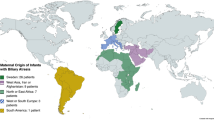Abstract
Background
The etiology of biliary atresia is still unknown. It is generally accepted that virus infection may be one of the important causes that lead to biliary atresia. This study aimed to illustrate the relationship between infection of cytomegalovirus and prognosis of biliary atresia.
Methods
From January 2002 to March 2004, 27 patients who had undergone Kasai’s procedure because of biliary atresia were investigated for cytomegalovirus-IgG, IgM and pp65, and their mothers were also examined for confirmation of cytomegalovirus infection. The patients were divided into three groups: infection free group, cytomegalovirus positive group and cytomegalovirus infection group. The rate of jaundice disappearance and the incidence of reflux cholangitis were analyzed statistically. The histopathological changes of the liver were also analyzed.
Results
The positive expression of cytomegalovirus-IgM and cytomegalovirus-pp65 in the patients was higher than that in their mothers (48% versus 14.81% and 37% versus 3.78%, respectively). Compared with the other two groups (80% in the infection free group, and 82% in the cytomegalovirus positive group), the rate of jaundice disappearance after operation in the cytomegalovirus infection group (36%) was significantly lower (P<0.05), and the incidence of reflux cholangitis was higher (P<0.05). Histopathological examination also showed that the degree of liver fibrosis and inflammation was more serious (P<0.05).
Conclusions
There is a strong correlation between cytomegalovirus infection and a lower rate of jaundice disappearance, also a higher post-operational reflux cholangitis. Liver fibrosis seems to be more severe in biliary atresia patients with cytomegalovirus infection.
Similar content being viewed by others
References
Petersen C, Ure BM. What’s new in biliary atresia. Eur J Pediatr Surg 2003;13:1–6.
Nio M, Ohi R, Miyano T, Saeki M, Shiraki K, Tanaka K; Japanese Biliary Atresia Registry. Five-and 10-year survival rates after surgery for biliary atresia: a report from the Japanese Biliary Atresia Registry. J Pediatr Surg 2003;38:997–1001.
Wang XH, Guo HM, Zhu QR, Wang DM. A clinical study on infantile cytomegalovirus infection and biliary atresia. J Appl Clin Pediatr 2005;20:274–276.
Scheuer PJ. Classification of chronic viral hepatitis. A need for reassessment. J Hepatol 1991;13:372–374.
Bonacini M, Hadi G, Govindarajan S, Lindsay KL. Utility of a discriminant score for diagnosing advanced fibrosis or cirrhosis in patients with chronic hepatitis C virus infection. Am J Gastroenteral 1997;92:1302–1304.
Fischler B, Haglund B, Hjern A. A population-based study on the incidence and possible pre-and perinatal etiologic risk factors of biliary atresia. J Pediatr 2002;141:217–222.
Howard ER, MacLean G, Nio M, Donaldson N, Singer J, Ohi R. Survival patterns in biliary atresia and comparison of quality of life of long-term survivors in Japan and England. J pediatr Surg 2001;36:892–897.
Szavay PO, Leonhardt J, Czech-Schmidt G, Petersen C. The role of reovirus type 3 infection in an established murine model for biliary atresia. Eur J Pediatr Surg 2002;12:248–250.
Barton ES, Youree BE, Ebert DH, Forrest JC, Connolly JL, Valyi-Nagy T. Utilization of sialic acid as a coreceptor is required for reovirus-induced biliary disease. J Clin Invest 2003;11:1823–1833.
Fishler B, Ehmst A, Forsgren M, Örvell C, Nemeth A. The viral association of neonatal cholestasis in Sweden: a possible link between cytomegalovirus infection and extrahepatic biliary atresia. J Pediatr Gastroenterol Nutr 1998;27:57–64.
Tarr PL, Hass JE, Christie DL. Biliary atresia, cytomegalovirus, and age at referral. Am Acad Pediatr 1997;97:828–831.
Oliveira NL, Kanawaty FR, Costa SC, Hessel G. Infection by cytomegalovirus in patients with neonatal cholestasis. Arq Gastroenterol 2002;39:132–136.
Kobayashi H, Horikoshi K, Yamatak A, Lane GJ, Furuhata A, Sueyoshi N, et al. Are stable postoperative biliary atresia patients really stable? Pediatr Surg Int 2001;17:104–107.
Wu ET, Chen HL, Ni YH, Lee PI, Hsu HY, Lai HS, et al. Bacterial cholangitis in patients with biliary atresia: impact on short outcome. Pediatr Surg Int 2001;17:390–395.
Ohhama Y, Shinkai M, Fuita S, Nishi T, Yamamoto H. Early predivtion of long-term survival and the timing of liver transplantation after the Kasai operation. J Petiatr Surg 2000;35:1031–1034.
Author information
Authors and Affiliations
Corresponding author
Rights and permissions
About this article
Cite this article
Shen, C., Zheng, S., Wang, W. et al. Relationship between prognosis of biliary atresia and infection of cytomegalovirus. World J Pediatr 4, 123–126 (2008). https://doi.org/10.1007/s12519-008-0024-8
Received:
Accepted:
Published:
Issue Date:
DOI: https://doi.org/10.1007/s12519-008-0024-8




